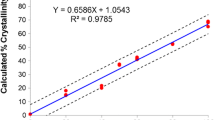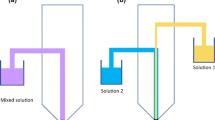Abstract
Purpose
The spray drying process is widely applied for pharmaceutical particle engineering. The purpose of this study was to investigate advantages and disadvantages of two-fluid nozzle and three-fluid nozzle spray drying processes to formulate inhalable dry powders.
Methods
Budesonide nanocomposite microparticles (BNMs) were prepared by co-spray drying of budesonide nanocrystals suspended in an aqueous mannitol solution by using a two-fluid nozzle spray drying process. Budesonide-mannitol microparticles (BMMs) were prepared by concomitant spray drying of a budesonide solution and an aqueous mannitol solution using a spray drier equipped with a three-fluid nozzle. The resulting dry powders were characterized by using X-ray powder diffraction (XRPD), differential scanning calorimetry (DSC), dynamic mechanical analysis (DMA) and Raman microscopy. A Next Generation Impactor was used to evaluate the aerodynamic performance of the dry powders.
Results
XRPD and DMA results showed that budesonide remained crystalline in the BNMs, whereas budesonide was amorphous in the BMMs. Spray drying of mannitol into microparticles resulted in a crystalline transformation of mannitol, evident from XRPD, DSC and Raman spectroscopy analyses. Both BMMs and BNMs displayed a faster dissolution rate than bulk budesonide. The yield of BNMs was higher than that of BMMs. The mass ratio between budesonide and mannitol was preserved in the BNMs, whereas the mass ratio in the BMMs was higher than the theoretical ratio.
Conclusions
Spray drying is an enabling technique for preparation of budesonide amorphous solid dispersions and nanocrystal-embedded microparticles. Two-fluid nozzle spray drying is superior to three-fluid nozzle spray drying in terms of yield.






Similar content being viewed by others
References
Smith IJ, Parry-Billings M. The inhalers of the future? A review of dry powder devices on the market today. Pulm Pharmacol Ther. 2003;16(2):79–95.
Dolovich MB, Dhand R. Aerosol drug delivery: developments in device design and clinical use. Lancet. 2011;377(9770):1032–45.
Zhou QT, Leung SS, Tang P, Parumasivam T, Loh ZH, Chan HK. Inhaled formulations and pulmonary drug delivery systems for respiratory infections. Adv Drug Deliv Rev. 2015;85:83–99.
Chow AH, Tong HH, Chattopadhyay P, Shekunov BY. Particle engineering for pulmonary drug delivery. Pharm Res. 2007;24(3):411–37.
Vehring R. Pharmaceutical particle engineering via spray drying. Pharm Res. 2008;25(5):999–1022.
Wan F, Maltesen MJ, Bjerregaard S, Foged C, Rantanen J, Yang M. Particle engineering technologies for improving the delivery of peptide and protein drugs. Journal of Drug Delivery Science and Technology. 2013;23(4):355–363.
Wan F, Maltesen MJ, Andersen SK, Bjerregaard S, Baldursdottir SG, Foged C, et al. Modulating protein release profiles by incorporating hyaluronic acid into PLGA microparticles via a spray dryer equipped with a 3-fluid nozzle. Pharm Res. 2014;31(11):2940–51.
Mizoe T, Ozeki T, Okada H. Application of a four-fluid nozzle spray drier to prepare inhalable rifampicin-containing mannitol microparticles. AAPS PharmSciTech. 2008;9(3):755–61.
Ozeki T, Beppu S, Mizoe T, Takashima Y, Yuasa H, Okada H. Preparation of two-drug composite microparticles to improve the dissolution of insoluble drug in water for use with a 4-fluid nozzle spray drier. J Control Release. 2005;107(3):387–94.
Ozeki T, Beppu S, Mizoe T, Takashima Y, Yuasa H, Okada H. Preparation of polymeric submicron particle-containing microparticles using a 4-fluid nozzle spray drier. Pharm Res. 2006;23(1):177–83.
Liu T, Han M, Tian F, Cun D, Rantanen J, Yang M. Budesonide nanocrystal-loaded hyaluronic acid microparticles for inhalation: in vitro and in vivo evaluation. Carbohydr Polym. 2018;181:1143–52.
European Directorate for Quality in Medicines and Healthcare (EDQM): European Pharmacopeia 9.0, Monograph 2.9.18. Preparations for Inhalation: Aerodynamic Assessment of Fine Particles. EDQM, Strasburg, France, 2017.
Bandi N, Wei W, Roberts CB, Kotra LP, Kompella UB. Preparation of budesonide- and indomethacin-hydroxypropyl-beta-cyclodextrin (HPBCD) complexes using a single-step, organic-solvent-free supercritical fluid process. Eur J Pharm Sci. 2004;23(2):159–68.
Boraey MA, Hoe S, Sharif H, Miller DP, Lechuga-Ballesteros D, Vehring R. Improvement of the dispersibility of spray-dried budesonide powders using leucine in an ethanol–water cosolvent system. Powder Technol. 2013;236:171–8.
Peltonen L, Hirvonen J. Pharmaceutical nanocrystals by nanomilling: critical process parameters, particle fracturing and stabilization methods. J Pharm Pharmacol. 2010;62(11):1569–79.
Shegokar R, Muller RH. Nanocrystals: industrially feasible multifunctional formulation technology for poorly soluble actives. Int J Pharm. 2010;399(1–2):129–39.
Yamasaki K, Kwok PC, Fukushige K, Prud'homme RK, Chan HK. Enhanced dissolution of inhalable cyclosporine nano-matrix particles with mannitol as matrix former. Int J Pharm. 2011;420(1):34–42.
Lee YY, Wu JX, Yang M, Young PM, van den Berg F, Rantanen J. Particle size dependence of polymorphism in spray-dried mannitol. Eur J Pharm Sci. 2011;44(1–2):41–8.
Hulse WL, Forbes RT, Bonner MC, Getrost M. The characterization and comparison of spray-dried mannitol samples. Drug Dev Ind Pharm. 2009;35(6):712–8.
Sharma VK, Kalonia DS. Effect of vacuum drying on protein-mannitol interactions: the physical state of mannitol and protein structure in the dried state. AAPS PharmSciTech. 2004;5(1):E10.
Mezzena M, Scalia S, Young PM, Traini D. Solid lipid budesonide microparticles for controlled release inhalation therapy. AAPS J. 2009;11(4):771–8.
Kaialy W, Nokhodchi A. Dry powder inhalers: physicochemical and aerosolization properties of several size-fractions of a promising alterative carrier, freeze-dried mannitol. Eur J Pharm Sci. 2015;68:56–67.
Kumon M, Kwok PC, Adi H, Heng D, Chan HK. Can low-dose combination products for inhalation be formulated in single crystalline particles? Eur J Pharm Sci. 2010;40(1):16–24.
Malamatari M, Somavarapu S, Kachrimanis K, Bloxham M, Taylor KMG, Buckton G. Preparation of theophylline inhalable microcomposite particles by wet milling and spray drying: the influence of mannitol as a co-milling agent. Int J Pharm. 2016;514(1):200–11.
Hu J, Dong Y, Ng WK, Pastorin G. Preparation of drug nanocrystals embedded in mannitol microcrystals via liquid antisolvent precipitation followed by immediate (on-line) spray drying. Adv Powder Technol. 2018;29(4):957–63.
Hao HX, Su WY, Barrett M, Caron V, Healy AM, Glennon B. A calibration-free application of Raman spectroscopy to the monitoring of mannitol crystallization and its polymorphic transformation. Org Process Res Dev. 2010;14(5):1209–14.
Maas SG, Schaldach G, Littringer EM, Mescher A, Griesser UJ, Braun DE, et al. The impact of spray drying outlet temperature on the particle morphology of mannitol. Powder Technol. 2011;213(1–3):27–35.
Burger A, Henck JO, Hetz S, Rollinger JM, Weissnicht AA, Stottner H. Energy/temperature diagram and compression behavior of the polymorphs of D-mannitol. J Pharm Sci. 2000;89(4):457–68.
Sosnik A, Seremeta KP. Advantages and challenges of the spray-drying technology for the production of pure drug particles and drug-loaded polymeric carriers. Adv Colloid Interf Sci. 2015;223:40–54.
Maury M, Murphy K, Kumar S, Shi L, Lee G. Effects of process variables on the powder yield of spray-dried trehalose on a laboratory spray-dryer. Eur J Pharm Biopharm. 2005;59(3):565–73.
Parumasivam T, Chang RY, Abdelghany S, Ye TT, Britton WJ, Chan HK. Dry powder inhalable formulations for anti-tubercular therapy. Adv Drug Deliv Rev. 2016;102:83–101.
Islam MIU, Langrish TAG. The effect of different atomizing gases and drying media on the crystallization behavior of spray-dried powders. Dry Technol. 2010;28(9):1035–43.
Hancock BC, Zografi G. Characteristics and significance of the amorphous state in pharmaceutical systems. J Pharm Sci. 1997;86(1):1–12.
Shetty N, Park H, Zemlyanov D, Mangal S, Bhujbal S, Zhou QT. Influence of excipients on physical and aerosolization stability of spray dried high-dose powder formulations for inhalation. Int J Pharm. 2018;544(1):222–34.
Debord B, Lefebvre C, Guyot-Hermann AM, Hubert J, Bouché R, Cuyot JC. Study of different crystalline forms of mannitol: comparative behaviour under compression. Drug Dev Ind Pharm. 2008;13(9–11):1533–46.
Ohrem HL, Schornick E, Kalivoda A, Ognibene R. Why is mannitol becoming more and more popular as a pharmaceutical excipient in solid dosage forms? Pharm Dev Technol. 2014;19(3):257–62.
Naini V, Byron PR, Phillips EM. Physicochemical stability of crystalline sugars and their spray-dried forms: dependence upon relative humidity and suitability for use in powder inhalers. Drug Dev Ind Pharm. 1998;24(10):895–909.
Jensen DM, Cun D, Maltesen MJ, Frokjaer S, Nielsen HM, Foged C. Spray drying of siRNA-containing PLGA nanoparticles intended for inhalation. J Control Release. 2010;142(1):138–45.
Adi H, Young PM, Chan HK, Agus H, Traini D. Co-spray-dried mannitol-ciprofloxacin dry powder inhaler formulation for cystic fibrosis and chronic obstructive pulmonary disease. Eur J Pharm Sci. 2010;40(3):239–47.
Eedara BB, Rangnekar B, Doyle C, Cavallaro A, Das SC. The influence of surface active l-leucine and 1,2-dipalmitoyl-sn-glycero-3-phosphatidylcholine (DPPC) in the improvement of aerosolization of pyrazinamide and moxifloxacin co-spray dried powders. Int J Pharm. 2018;542(1–2):72–81.
Adi S, Adi H, Tang P, Traini D, Chan HK, Young PM. Micro-particle corrugation, adhesion and inhalation aerosol efficiency. Eur J Pharm Sci. 2008;35(1–2):12–8.
Noyes AA, Whitney WR. The rate of solution of solid substances in their own solutions. J Am Chem Soc. 1897;19:930–4.
Author information
Authors and Affiliations
Corresponding author
Electronic supplementary material
ESM 1
(DOCX 101 kb)
Rights and permissions
About this article
Cite this article
Leng, D., Thanki, K., Foged, C. et al. Formulating Inhalable Dry Powders Using Two-Fluid and Three-Fluid Nozzle Spray Drying. Pharm Res 35, 247 (2018). https://doi.org/10.1007/s11095-018-2509-z
Received:
Accepted:
Published:
DOI: https://doi.org/10.1007/s11095-018-2509-z




